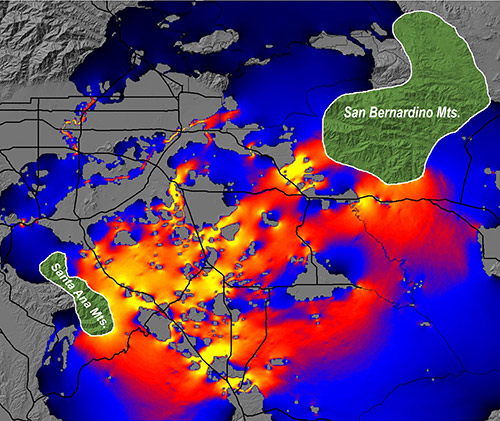
Scientists map the “current” of mountain lions moving between mountain ranges. Blue shows areas of low current density, which are expected to have low densities of dispersing mountain lions; yellow designates movement bottlenecks, which are most vulnerable to habitat destruction. Destroying high-flow habitat can isolate populations and endanger their survival. Image: Brad McRae and Brett Dickson
PyAMG is an open-source numerical package of multigrid and Krylov solvers for sparse matrices in Python. One of the biggest users of PyAMG is Circuitscape. This open-source software program borrows algorithms from electronic circuit theory to predict patterns of movement, gene flow, and genetic differentiation among plant and animal populations in heterogeneous landscapes. Circuit theory complements least-cost path approaches because it considers effects of all possible pathways across a landscape simultaneously.
Circuitscape was written by Brad McRae and Viral Shah. Brad is an Ecologist with the The Nature Conservancy in Seattle. He works on habitat connectivity conservation, climate change, and landscape genetics. Viral is a Senior Scientist with Interactive Supercomputing and a Visiting Scientist at the University of California, Santa Barbara. He develops systems for scientific computing for work and for fun.
For additional information on `Circuitscape`_:
The authors presentation at SciPy 2008: http://www.circuitscape.org/Circuitscape/Pubs_files/Shah_McRae_Circuitscape_Python_Scipy08.pdf.
Conservation Magazine: Circuitous Routes: Circuit Theory Guides Wildlife Corridor Design by Eric Wagner
Wired Magazine: Scientist Employs ‘Circuit Theory’ to Protect Endangered Species by Carl Zimmer
Convergence Magazine: Where the Wild Things Are by Anna Davison
Earthtimes.org: Where Mountain Lions Roam: Star-P Helps Decipher Threatened Wildlife Migration

